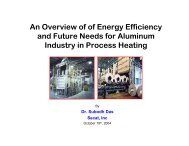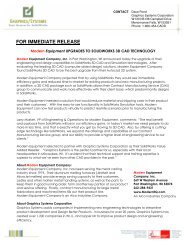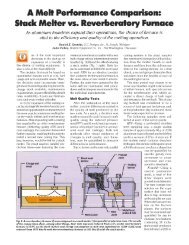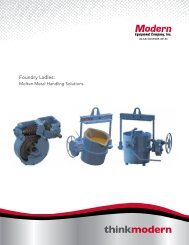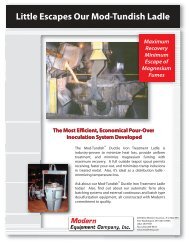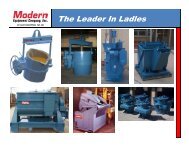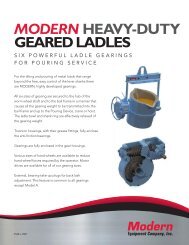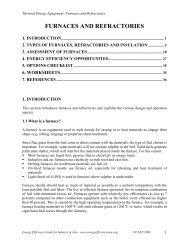ITP Metal Casting: Advanced Melting Technologies: Energy Saving ...
ITP Metal Casting: Advanced Melting Technologies: Energy Saving ...
ITP Metal Casting: Advanced Melting Technologies: Energy Saving ...
Create successful ePaper yourself
Turn your PDF publications into a flip-book with our unique Google optimized e-Paper software.
scrap preheating system must be of large capacity to capture the energy from combustion, this<br />
system is also impractical for foundry operations.<br />
4.6.2 Twin Shell System<br />
Preheating systems have been in use for more than a decade in electric arc furnace steel melting<br />
shops. Twin-shell furnaces are among the more recent developments, incorporating preheating as<br />
an integral part of the melting process. At a twin-shell operation, while one part of the furnace is<br />
making steel, the other side is being loaded with scrap. The off-gas from the operating side of the<br />
two-furnace system is piped to the other side to heat the charge before melting. Generally, this<br />
technology is used with a single graphite electrode DC furnace.<br />
The off-gas from the current heat being melted or refined is passed through the scrap for the next<br />
heat in the second furnace shell. Typically, only the first charge is preheated. Therefore, most<br />
plants try to operate with a single charge. Twin shell systems are cheaper than having two<br />
separate electric arc furnaces because they require only one set of electrodes and achieve similar<br />
production rate. Electricity costs are also lower with the twin shell system. When two scrap<br />
charges are required, the first (preheated charge) contains approximately 60% more scrap than<br />
the second charge. Preheating in the second shell can also be supplemented by gas burners.<br />
Nippon Steel reported energy consumption of 260 kWh/ton steel with preheating to about 900°C<br />
(1,650°F), achieving a 30% energy reduction from conventional melting. This technology is<br />
applicable to larger foundries’ arc furnaces (greater than 20 ton) but would be difficult to retrofit<br />
as it requires replacement of furnaces.<br />
4.7 Refractories<br />
Refractories are used throughout the various processes conducted in all kinds of furnaces in the<br />
metal casting industry, affecting approximately 90% of the direct energy consumption in these<br />
processes. Improvements in refractory systems, such as life extension, offer high potential to<br />
save energy up to 8.5 trillion Btu per year.<br />
g<br />
t<br />
83 Ceramic linings are used in most furnaces to<br />
minimize reaction resulting in corrosion or mechanical damage in the furnace when processin<br />
specific metals. Although the service life of refractory linings has been extended in the las<br />
decade, there still exists a substantial problem where thermal efficiency may be sacrificed for a<br />
better protective refractory lining.<br />
A recent development in insulating materials is the use of micro-porous silica. The improved<br />
opacifiers<br />
block heat transfer in radiation lowering thermal conductivity. The low thermal<br />
conductivity can increase the capacity of ladles, kilns, industrial ovens and commercial<br />
appliances while maintaining or improving thermal performance. It can reduce weight, which<br />
in<br />
turn, can reduce structural requirements for furnaces and other high-temperature vessels.<br />
The development of insulation system within refractory system also ensures proper temperature<br />
control<br />
in melting systems (for example, maintaining a homogeneous aluminum liquid<br />
throughout the aluminum melter). The board form of the new insulation materials can backup<br />
33



